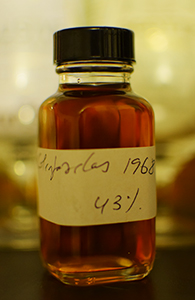
This is one of two older Glenfarclas exclusives that were released in the US in the early-mid 2000s. The other was a 1974-2005 that I purchased south of $200 from Binny’s about five years ago. At the time this older 1968 vintage release (I’m not sure if it was bottled in 2003 or 2004) was still around but cost $50-100 more, depending on where you looked. Back then I was not in the practice of buying a lot of expensive whisky and so I passed; I think I also figured that since it had hung around for the better part of a decade already it wouldn’t be disappearing any time soon. Of course, this was a silly thing to do. By the time I wised up it was all gone—as was pretty much every other glut-era old malt that had hung around for a decade at stores like Binny’s. Anyway, I got to taste it again last month at another of my friend Rich’s Twin Cities malt gatherings—this one dedicated to sherried whiskies—and our friend Nick, who’d brought this bottle, was kind enough to share some more of it so I could at least review it. Here is that review.
Glenfarclas 35, 1968 (43%; US exclusive; from a sample from a friend)
Nose: Leather, dark honey and then a massive wave of fruit: dried apricot, marmalade, plum sauce, brandied raisins. Behind the fruit is some soy sauce, some wood smoke and fast expanding pipe tobacco. The fruit gets brighter and more tropical as it sits with hints of pineapple and mango joining the darker fruit. With a drop of water it’s just a little bit brighter and the leather and wood smoke recede.
Palate: As repped by the nose: no point repeating myself. The mouthfeel is a bit thin but that’s my only complaint and it’s a minor one. With time the tropical accents on the fruit are stronger here than on the nose and it gets richer with every sip. Hints of bitter chocolate and coffee grounds with more time. With water there’s a bit of savoury gunpowder.
Finish: Medium-long. The leathery note and the marmalade hang out the longest and just a touch of oak emerges to frame them at the end. Not much change here with water.
Comments: Wonderful, classy stuff and I wish I had bought a couple of these when I had the chance. By far the fruitiest Glenfarclas I’ve ever had—very much in old Longmorn and Strathisla territory. Is this normal for Glenfarclas from this era and of this age?
Rating: 92 points.
Thanks to Nick S. for the sample!

If only the SWA would allow for the reintroduction of Paxarette, whiskies like this might be possible to recreate in the future.
LikeLike
I’m sorry–having only recently woken up, my irony detector is not fully operational and so I’m unsure of how I should read this comment. I also know little about Paxarette.
LikeLike
It’s kinda funny—Paxarette seems like the kinda thing that whisky geeks would hate, but it’s usually remembered fondly. I guess the results were worth the adulteration.
(I don’t know much about it either, being just a modern drinker. I’ve just heard about it.)
LikeLike
The ’68 Glenfarclas fruityness (usually plus a fair amount of beeswax) does not have anything to do with Paxarette… but is more in line with flavour profiles known from mid 50s to early 70s Glen Grants, Longmorns & Strathislas indeed.
Paxarette is, since there’s the occasional recipe posted here (which I do enjoy a lot) and what a modern chef would describe as, a sherry reduction. Taste wise, think raisin-concentrate (what PX sherry already is imo) cooked down even further into a molasses resembling goo. This was being miss-used when the whisky industry experimented with cask ‘rejuventation’ & ‘seasoning’ (i.e. high pressure injection…) in 70s & 80s and found paxarette to be a cheap way to get something similar to fresh and expensive sherry casks – so tell tale signs are coke-coloured whiskies (which this is not) from around that era – there’s urban myths about Black Bowmore bottlings being pimped up with paxarette as well as E150…
LikeLike
Thanks for that!
LikeLike